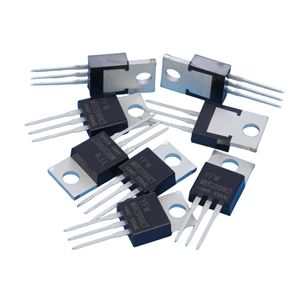Date:2024-09-25 Categories:Product knowledge Hits:403 From: Guangdong Youfeng Microelectronics Co., Ltd(YFW)
What are the effects of steady-state and transient characteristics of silicon carbide diodes on PFC? What state will occur when restoring current in reverse?
1: The influence of steady-state and transient characteristics of silicon carbide diodes on PFC
The basic topology structure of continuous mode Boost converter. It is widely used in power factor correction circuits, with inductor current in continuous mode. In this circuit, the steady-state and transient characteristics of the diode have a significant impact on the PFC circuit.
2: Steady state characteristics - forward voltage Uf. Silicon material ultrafast recovery diode (15A/600V) is tested for forward voltage drop at room temperature. At 2-5A, the forward voltage drop remains basically unchanged and approaches saturation, indicating from another perspective that silicon material diodes have negative temperature characteristics as the forward voltage drop decreases at high temperatures.
Silicon carbide Schottky diode (4A/600V) is tested for forward voltage drop at room temperature. When the load current changes from 0 to 4A, the forward voltage drop basically increases linearly. From another perspective, this indicates that the forward voltage drop of silicon carbide Schottky diodes increases linearly at high temperatures, indicating that silicon carbide diodes have positive temperature characteristics.
In high-power PFC circuits, diodes may need to be used in parallel to increase capacity, and the issue of uniform current distribution in the devices needs to be considered. The characteristics of the forward voltage and on resistance of the diodes are key. The unique positive temperature coefficient characteristic of silicon carbide Schottky diodes can ensure the current sharing requirements when the devices are connected in parallel.
3、 Transient characteristics - reverse recovery current
There are many types of diodes, but only Schottky barrier diodes are responsible for carrying current through the majority carriers, without any excess minority carrier recombination. The recovery time is very small, about tens or hundreds of ps. The disadvantage is that their voltage resistance is very low. The task of carrying current in other silicon diodes (such as ordinary diodes, fast diodes, and ultrafast recovery diodes) is completed by minority carriers, which poses a problem of reverse recovery time. The two ultrafast recovery diodes used have Trr times of 30ns and 13ns, respectively,
But it cannot avoid the problem of reverse current.
Due to the characteristics of the material, silicon carbide Schottky diodes have both advantages. They not only have very high voltage resistance, but also have excellent reverse recovery and temperature characteristics. The reverse current and reverse recovery time of silicon rectifier tubes will increase with the increase of temperature. The reverse recovery time and reverse current of silicon carbide Schottky diodes are very small, and they have excellent temperature characteristics. Their reverse recovery time does not change with increasing temperature. At room temperature of 25 ℃, the reverse recovery time of the ultrafast recovery diode is three times that of the silicon carbide Schottky diode, and the reverse current is four times that of the silicon carbide Schottky diode. At a high temperature of 150 ℃, the reverse recovery time of the ultrafast recovery diode is 6 times that of the silicon carbide Schottky diode, and the reverse current is 12 times that of the silicon carbide Schottky diode.
Generally speaking, we hope that the reverse recovery time of diode D1 in single-phase PFC circuits is as short as possible. Reverse recovery current can bring us many problems, such as diode reverse recovery loss and severe MOSFET turn-on loss caused by it. Many soft switching or lossless absorption technologies have been applied to PFC circuits, which is a typical lossless absorption application aimed at overcoming the problems caused by the reverse recovery time of diodes. It can achieve near zero current turn-on and zero voltage turn off of the main switch tube, while the boost diode turns off at zero current, improving the efficiency of PFC. But in this type of circuit, the resonant voltage of the diode will be relatively high, even reaching the rated voltage of the diode. At the same time, more components are used, which increases the cost and reduces the reliability of the system.

Previous: Classification, Structure, and Principle of MOSFET